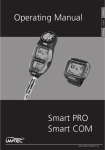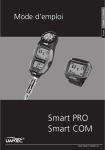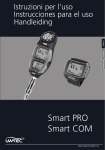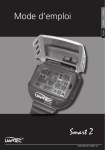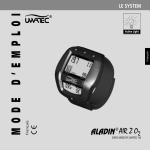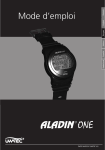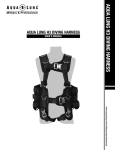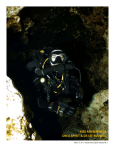Download User's Guide
Transcript
PULSE Nitrox Dive Computer User's Guide Contents FOR YOUR SAFETY................................................. 5 INTRODUCTION .................................................... 8 SECTION 1 - Using the Pulse on the Surface ............ 9 The Push Buttons ......................................................................... 10 Mode Indicators............................................................................ 11 Time Display Mode (pre-dive)..................................................... 12 Backlight ................................................................................16 Low Battery Indicator ...............................................................16 Time Display Mode (post-dive) ................................................... 17 Wait-to-fly Guidelines ................................................................... 19 Setting the Time, Date & 12/24 Hour Format ........................... 20 Plan Mode/Plan Simulator.......................................................... 26 Plan Simulator ........................................................................28 Setting Alarms............................................................................... 30 Turning Alarms on and off .......................................................30 2 Pulse Owner's Manual Alarm Clock Setting..................................................................31 Setting Dual Time......................................................................... 32 Logbook Mode ............................................................................. 34 Logbook Page 1 ........................................................................35 Logbook Page 2 ........................................................................38 Logbook Page 3 ........................................................................40 Profile Mode ................................................................................. 42 Transfer Data Mode...................................................................... 44 Change Units of Measure ............................................................ 46 SECTION 2- Diving With The Pulse ........................ 47 Pre-Dive Checklist......................................................................... 48 Automatic Activation .................................................................... 49 Testing the water contact ...........................................................49 No-decompression Dive Mode..................................................... 50 Primary Display .......................................................................50 Alternate Display 1...................................................................52 3 Alternate Display 2...................................................................54 Safety Stop...............................................................................55 Decompression Dive Mode .......................................................... 56 Summary of Warnings and Alarms .............................................. 58 FO2 Warning ..........................................................................58 Fast Ascent Warning ................................................................58 PO2 Warning..........................................................................59 Decompression Stop Violation Warning........................................59 Oxygen Bar Graph Warning......................................................60 Out-of-Range Warning .............................................................60 Gage Mode.................................................................................... 62 Primary display .......................................................................62 CARE & MAINTENANCE....................................... 64 Care before the dive ...................................................................64 Care during the dive .................................................................65 Care after the dive ....................................................................65 Changing the Battery................................................................66 4 Pulse Owner's Manual FOR YOUR SAFETY All warnings and cautions are identified with the triangle symbol. Whenever you see a warning or a caution, read it carefully, as it may protect you from serious injury or damage to the product. Read the manual in its entirety before attempting to use the Pulse computer. WARNING: Decompression sickness (aka, “the bends”) is an inherent risk of SCUBA diving. Even if you properly follow all the instructions in this manual, and dive within the recreational limits of SCUBA diving, you still run the risk of getting decompression sickness, or some other inherent risk of SCUBA diving. Unless you are fully aware of these risks and are willing to personally accept and assume responsibility for those risks, do not use the Pulse dive computer The Pulse, or any other dive computer, does not actually monitor changes that occur in your body as you dive. Rather, it is performing calculations using algorithms developed by leading decompression 5 experts and backed by years of research and thousands of dives. However, these algorithms cannot account for factors like dehydration, fatigue, obesity, or poor physical conditioning. Therefore, always leave a comfortable safety margin in respect to no-decompression time and ascent speed. The computer is designed to ASSIST you in making a dive, not to CONTROL your dive. 6 Pulse Owner's Manual WARNING: Using the Pulse will not prevent decompression sickness, but using it sensibly reduces this risk. You must accept that there is no device or procedure that will totally prevent the possibility of a decompression accident. 7 INTRODUCTION Congratulations on the purchase of your new Pulse dive computer. As with all diving equipment, it is important to understand the features and functions of the Pulse. Before using the computer, read this manual in its entirety. Contained within this manual are illustrations to aid you in understanding the computer. Section 1 instructs you on how to navigate through the Pulse’s surface modes. Section 2 describes all the underwater displays and functions while diving with the Pulse. Lastly, Section 3 covers care & maintenance. This manual will clearly and concisely instruct you on the use of the Pulse. However, if you have any questions on the material contained in this manual, please contact your nearest authorized dealer. 8 Pulse Owner's Manual SECTION 1 Using the Pulse on the Surface 9 The Push Buttons The Pulse has four buttons that allow you to access modes, change settings and switch displays. Next to each button is a label (MODE, LOCK, SELECT and SET, see Figure 1). These labels are primarily related to the various set modes, such as Time Set Mode and Dive Set Mode. However, the buttons have different functions in other modes, such as Plan Mode or Dive Mode. It is important to thoroughly read and understand the manual so you know the functions of the buttons in all situations. Figure 1. The push buttons 10 Pulse Owner's Manual Mode Indicators At the bottom of the LCD are six mode indicators: D.S (dive settings), PLAN (plan mode), AL (alarm settings), D.T (dual time setting) LOG (logbook), and PROF (profile). Details on accessing and entering these modes are explained later in the manual. Figure 3. Mode Indicators Dive Set Mode Plan Mode Alarm Set Mode Dual Time Set Mode Logbook Memory Profile Memory 11 Time Display Mode (pre-dive) a b e c f g h d 12 Figure 3. Time Display Mode Pulse Owner's Manual The Pulse’s default mode is the Time Display Mode (figure 3). The computer always returns to the time display after making a dive or exiting from one of the other modes, such as Plan Mode or Log Mode. If there is no button activity for several minutes while in another mode, the computer will automatically exit back to the time display. a. Day: Day of the week: b. Date: Displayed in month-day format. c. Time of day: Displayed in 12-hour or 24-hour format. The 24-hour format does not use AM and PM. For example, 15:45 is the same as 3:45 PM. Selecting the 12- or 24-hour format is explained on page 21. d. Dual Time: Dual time shows the time in a different time zone. If Dual time is set the same as the current time, it will not be displayed. e. Alarm clock icon: If the alarm clock is turned on, the icon will appear. continued... 13 f. Hourly alarm icon: If the Pulse is set to sound an alarm every hour, the bell icon will be displayed g. Nitrox indicator: If FO2 for mix 1 has been set to 22% or higher, the Nitrox indicator will be displayed. See page 23 for more info on nitrox settings. CAUTION: If the Nitrox indicator is flashing, it means that the Pulse has defaulted to 99% FO2. You must reset the FO2 to match the contents in your cylinder. h. Altitude sector: The Pulse automatically adjusts for altitudes up to 19,680 ft. (6000 m). The following table lists the altitude sectors and their corresponding altitude range. WARNING: When diving at altitude, make sure the altitude sector matches the actual elevation of the dive site, otherwise, the Pulse may display inaccurate information. Note: When arriving at a new altitude sector, segments on the nitrogen loading bar graph may appear, even if you have not made a dive. 14 Pulse Owner's Manual Sector Altitude Range Sea Level to 2624 ft (800 m) 2624 ft (800 m) to 5248 ft (1600 m) 5248 ft (1600 m) to 7872 ft (2400 m) 7872 ft (2400 m) to 19680 ft (6000 m) Error. Icons flash above 19680 ft (6000 m) 15 Backlight To activate the backlight, press SET. The backlight will stay on for 3 seconds. Low Battery Indicator When the battery power is too low for the computer to function properly, the Pulse displays a battery icon (see figure 4). When the battery icon is blinking, you can place the computer into Transfer Mode to download your dive profiles to a PC, but it will not enter dive mode. When the battery icon stops blinking, you cannot dive with the computer and will not be able to transfer to a personal computer. Figure 4. Low Battery Warning 16 Pulse Owner's Manual Time Display Mode (post-dive) After making a dive, the Time Display Mode shows additional information (figure 5): a. Nitrogen Bar Graph. The Nitrogen bar graph is a series of nine segments that graphically represent your body’s residual nitrogen. During the surface interval, the Nitrogen Bar Graph starts to recede, indicating that you are off-gassing nitrogen. b. Oxygen Bar Graph. The Oxygen Bar Graph is a series of eight segments that graphically represent your CNS clock. It tracks your exposure to higher partial pressures of oxygen when diving with enriched air nitrox. b a Figure 5. Time Display - Post Dive 17 To view desaturation time and surface interval time, press SELECT (see figure 6). a. Desaturation Time: Desaturation time is the amount of time it takes to release all the residual nitrogen left in your body from previous dives. Any dive made while there is still desaturation time remaining is considered a repetitive dive. b. Surface Interval Time: Surface interval time is the amount of time since surfacing from a dive. It is displayed until desaturation time reaches zero. 18 b a Figure 6. Press SELECT to view Desaturation Time and Surface interval Time Pulse Owner's Manual Wait-to-fly Guidelines The Undersea and Hyperbaric Medical Society (UHMS) suggests that divers using standard air tanks and exhibiting no symptoms of decompression sickness wait 24 hours after the last dive to fly in an aircraft with a cabin pressure of 8000 feet (2438 m) or less. The two exceptions to this recommendation are: 1. Less than two hours of dive time in the last 48 hours, then wait 12 hours before flying. 2. Following a decompression stop dive, wait at least 24 hours or, if possible, 48 hours. Both UHMS and Divers Alert Network (DAN) agree that there can never be a flying after diving rule that is guaranteed to prevent decompression sickness. Rather, there can be a guideline that represents the best estimate for a conservative surface interval for the vast majority of divers. There will always be an occasional diver whose physiological makeup or special diving circumstances will result in decompression sickness. 19 Setting the Time, Date & 12/24 Hour Format D EN TE R/E XI T Figure 7. Tine, date, 12/24 hour setting 20 XT NE EL FI CH AN GE SE TT IN G Pulse Owner's Manual 1. To set the time and date, press LOCK. Dual Time starts to flash. 2. Press SET to swap the Dual Time with the Time of Day; Press SELECT to accept the setting and move to the next field. 3. The time and date are set in the following order: Seconds, minutes, hours, year, month, and day. To change the setting press SET. To accept the setting and move to the next field, press SELECT. 4. After the time and date are set, the hours:minutes will start to flash. Press SET to toggle between the 12-hour and 24-hour display. 5. To exit the Time Set mode, press LOCK. 21 Dive Settings Mode Dive Settings Mode allows you set all the parameters related to the operation of the computer during a dive. f EN T ER /EX g XT NE IT D EL FI a b d e Figure 8. Dive Settings 22 CH c AN GE SE TT IN G Pulse Owner's Manual 1. To view the Dive Settings, press MODE once so the mode indicator is above D.S. The computer will display the following information (figure 8): a. Operational Mode: If set to DIVE, the Pulse will function as a complete dive computer and calculate no-decompression, decompression and oxygen related information. If set to GAGE, the Pulse will become a basic depth gauge and timer. For more information on these modes, review Section 2, Diving with the Pulse. b. Nitrox Mix 1: The FO2 setting for Mix 1 may be set for Air (21%) to 50%. c. Nitrox Mix 2: The FO2 setting for Mix 2 may be set for Air (21%) to 99%. d. Maximum Operating Depth (MOD): MOD is calculated automatically and is based on a PO2 of 1.4 for Mix 1 and 1.6 for Mix 2. 23 e. Safety Factor (SF): The safety factor may be set to 0 or 1. When set to 0, the computer will perform calculations based on the current altitude setting. If set to 1, the calculations are made as though the computer was at one altitude sector higher. This adds in an extra level of conservatism. f. Water type: Actual depth can differ based on the salinity of the water. If you are diving in a fresh water lake or river, set the Pulse to Fresh; if diving in seawater, set it to Sea. g. Profile recording interval: The pulse can record depth measurements every 15 or 30 seconds. If set to 15, memory capacity is cut in half. 2. To make changes to the settings, press LOCK. 3. Press SET to change the setting; press SELECT to accept the setting and move to the next field. To exit the mode, Press LOCK. IMPORTANT NOTE: 24 If either mix is set to 22% or higher, the Pulse will default the FO2 for Pulse Owner's Manual that mix to 99% at midnight; if either mix is set to Air, it will stay set to Air indefinitely. - If mix 1 defaults to a 99% FO2, it will be denoted by the flashing Nitrox label . This 99% default is built in to protect you from making subsequent nitrox dives with the wrong FO2 setting. If you make a dive with the FO2 set to 99%, an audible alarm will sound upon entering the water. Return to the surface and reset the FO2 to the proper percentage. If you continue the dive, you will reach the PO2 limit at about 20 feet (6 m). Again, return to the surface and reset the FO2 to the proper percentage. - If Mix 1 defaults to 99%, the no-decompression and decompression calculations will be calculated as though you were diving with normal air (79% nitrogen). Therefore, the Pulse calculates a worst-case scenario (99% Oxygen, 79% Nitrogen). At worst, the computer will be more conservative on subsequent dives. - If only Mix 2 defaults to 99% (Mix 1 set to Air), you will only get an audible warning when entering the water. Upon hearing the warning, return to the surface and reset the Mix. 25 Plan Mode/Plan Simulator Plan Mode allows you to review the no-decompression time limits at various depths for the next dive. e PL AN b TH SI MU LA TO *Only available between repetitive dives T EX P DE N R* a Figure 9. Plan Mode PR EV d 26 c IO US DE PT H Pulse Owner's Manual 1. To enter Plan Mode, press the MODE button twice so the mode indicator is above PLAN. Once in Plan Mode, the computer will display the following information (figure 9): a. Plan Depth. The computer will display the plan depths in 3m/10 ft., increments starting at 9m/30 ft. b. No-decompression limit (NDL). This is the maximum amount of time you can stay at the given depth before requiring mandatory decompression stops. If you set Mix 1 to 22% or higher and you exceed your Maximum operating Depth (MOD), three dashes (- - -) will be displayed. c. Nitrox Mix 1. You need to make sure the FO2 accurately matches the actual breathing gas in your cylinder. (See “Dive Settings Mode” on page 22). d. Safety Factor (SF) e. Water type 27 2. To scroll through the time/depth combinations, press SELECT to go deeper or press SET to go shallower. Note that there is a short delay between the appearance of the next depth and the display of the NDL time. 3. To exit Plan Mode, Press MODE. To switch to Plan Simulator, press LOCK. (Note: Plan Simulator is only available between repetitive dives with a minimum 10 minute surface interval). Plan Simulator The Plan Simulator is only available between dives, not before the first dive. Plan Simulator allows you to enter addition surface interval time to your current interval time and lets you see no-decompression times out in the future. In addition, the Plan Simulator will display the PO2 for each depth. 1. While in Plan Mode, press LOCK. Surface time (a) and PO2 (b) will appear (figure 10). 2. Press SELECT to add surface interval time in 30 minute increments. 28 Pulse Owner's Manual 3. Press SET to change depths. For each depth the Pulse will display the no decompression lime and PO2. 4. To exit back to Plan Mode, press LOCK. PL AN M OD E D AD RF SU TI E M a b Figure 10. Plan Simulator NE XT DE PT H 29 Setting Alarms The Pulse has an alarm clock and an hourly alarm . The alarm clock goes off at a time that you set; the hourly alarm goes off at the top of every hour. Turning Alarms on and off 1. Press the MODE button three times so the mode indicator is above AL. The alarm setting is displayed along with FF /O ON the two alarm icons (if active). S M AR AL 2. 30 If the alarm setting is OK and all you want to do is turn the alarms on or off, press SELECT. Continue to press SELECT until one or both the icon displays are visible. Figure 11. Alarms on/off Pulse Owner's Manual Alarm Clock Setting 3. To change the alarm setting, press LOCK. The hours start to flash. Press SET to change. Press SELECT to accept the setting and move to minutes. EN TE R T EX /EX IT 4. E FI LD N To exit, press LOCK Figure 12. Setting alarm clock CH AN GE SE TT IN G 31 Setting Dual Time EN TE R/ EX IT Figure 13. Setting Dual Time 32 S. + 30 -3 0 M IN M IN S. Pulse Owner's Manual Dual Time shows the time in a different time zone, a handy feature when travelling. If Dual Time matches current time, it will not be displayed. 1. Press the MODE button four times so the mode indicator is over D.T. 2. Press LOCK. Dual time starts to flash. 3. Press SET to lower the time in 30 minute increments; press SELECT to increase the time. Dual Time can be set 24 hours ahead or behind, and the date will change accordingly. 4. Press LOCK to exit the setting mode. 33 Logbook Mode The Pulse logs any dive that is at least 1.5m/5 ft., and has a dive time of at least three minutes. The Pulse's memory capacity is 30-hours or 60 logged dives if the sampling rate is set to 30 seconds. If the sampling rate is set to 15 seconds, the logbook capacity is cut in half to 15 hours or 30 logged dives. When the memory is full, the newest dives will overwrite the oldest dives. The memory stays intact indefinitely, even after a battery change. It is strongly recommended, however, that you download all your dives and/or enter them into your logbook before changing the battery. The Pulse logs more information than can be displayed on a single screen; therefore, the logbook displays three "pages" of information for each dive. 34 Pulse Owner's Manual 1. Press the MODE button five times so the mode indicator is over LOG. Page 1 of the most recent dive is displayed. 2. Press SET to go to page 2 3. Press SET again to page 3 or press SELECT to go back to page 1 4. If on page 3, press SET to go to the first page of the next dive. If on page 1, press SELECT to go to page 3 of the previous dive. Press and hold SET or SELECT to quick move forward or backward through the logbook. 5. To view the profile of the dive, press MODE (Profile Mode is explained in the next section). Logbook Page 1 (see figure 14) a. Log Number: This is the sequential number of the dive relative to all the other dives in memory. The higher the number, the newer the dive, i.e., dive 1 is the oldest dive in memory. b. Page Number: The page is displayed as 1/3. (1 of 3), 2/3 (2 of 3), and 3/3 (3 of 3). 35 h i b j E Figure 14. Logbook Page 1 S OU VI E PR a c e OF V W IE PR d ILE NE g 36 G PA f l k XT PA GE Pulse Owner's Manual c. Date: The date the dive started. d. Dive number: The number of the dive made that day. e. Start time: The time of day that the dive started. f. End time: The time of day that the dive ended. g. NITROX indicator: If the FO2 was set to 22% or higher, the computer records that it was a nitrox dive. h. Residual nitrogen: The residual nitrogen at the end of the dive. This is not displayed if it was a Gage Mode dive. i. Water type: The water type setting when the dive was made. j. Oxygen level: The oxygen level at the end of the dive. k. Mix indicator: Denotes if one or both mixes were used during the dive. l. Altitude Sector: The altitude sector when the dive started. 37 Recorded violations (not shown) a. Decompression: If a decompression dive was made, the DECOSTOP label will be displayed; if the decompression stop was violated, the DECOSTOP label will flash. b, Fast ascent: If the ascent rate was violated, the SLOW label will flash. c. PO2 violation: If you exceed the maximum operating depth for either mix, the PO2 label will flash. d. Out of range: If a dive was made that exceeded the depth limit or at an altitude over 6000m/19,685 ft., the entire display will flash. Logbook Page 2 (see figure 15) a. Dive time: This is the total time spent below 1.5m/5 ft. b. Average depth: The average depth of the dive. c. Water temperature: The lowest temperature recorded during the dive. 38 Pulse Owner's Manual E Figure 15. Logbook Page 2 S E PR OU VI G PA a b ILE NE OF EW VI PR XT PA G E c 39 Logbook Page 3 (see figure 16) a. Maximum depth: The deepest depth reached during the dive b. Safety factor setting: The safety factor setting when dive was made c. Mix 1: The FO2 setting for Mix 1 when dive was made. d. Mix 2: The FO2 setting for Mix 2 when dive was made. 40 Pulse Owner's Manual E US IO EV Figure 16. Logbook Page 2 PR a c ILE NE OF EW VI PR G PA XT PA G E b d 41 Profile Mode In addition to the basic logbook data, the Pulse also records the dive depth every 15 or 30 seconds (see Dive Mode Settings on page 22). The Profile Mode plays back the profile so you can manually plot the dive profile. This profile information is also downloadable to a PC. 1a. To view the most recent dive profile, press the MODE button six times so the mode indicator is over PROF. - or 1b. To view the profile of a particular dive, go into Log Mode, scroll to the dive you want to profile, then press MODE. 2. The Pulse will automatically start scrolling through the profile. To pause the profile, press and hold SET. 3. To go to a previous dive, press SELECT 4. To exit Profile Mode, press MODE. In Profile Mode, the Pulse displays the following information: 42 Pulse Owner's Manual PC TR AN CK BA SF ER a 1 VE DI b c IT EX PA US E E OD M Figure 17. Profile Mode d 43 a. Profile number: This is the sequential number of the dive in memory. b. Dive time: This is the minute display during the dive. If the profile recording was set to 30 seconds, you will see two depth readings for each minute; if set to 15 seconds, you will see four depth readings per minute. c. Depth: The depth where the sampling occurred. d. Mix: The mix setting used at that point during the dive Transfer Data Mode You can download the logbook and profile data to a personal computer using the optional PC interface kit. 1. Go into Profile Mode as explained in the previous section. 2. Press LOCK to start the Transfer Data Mode 3. At this point, you can attach the computer to the interface and upload your data to the PC. 44 Pulse Owner's Manual 4. To exit this mode and return to Profile Mode, press LOCK. WARNING: The Pulse cannot enter Dive Mode while in Transfer Data Mode. You must exit Transfer Data Mode before attempting to dive. Otherwise, the computer will not perform any nitrogen or oxygen calculations, which may lead to serious injury or death. Figure 18. Transfer Data Mode 45 Change Units of Measure The Pulse allows you to change the units of measure from Imperial (feet, °F) to Metric (meters, °C), or vice versa. 1. Press MODE twice so the mode indicator is over PLAN. 2. Press and hold LOCK for 5 to 6 seconds. An audible alarm will sound and the depth display will switch to the new metric or imperial setting. 46 Pulse Owner's Manual Section 2 DIVING WITH THE PULSE WARNING: Never use the Pulse unless it has been with you since the first dive. Using a “clean” computer (no residual nitrogen) after you have already made a dive(s) may result in the computer allowing you more no-decompression time than you really have. In addition, never share or swap computers. Any of these practices may result in decompression sickness. 47 Pre-Dive Checklist Before making a dive, it is important that you make sure you go through the following checklist: 1. Make sure the time and date is set correctly. Remember, the Pulse records the time and date of each dive into memory. 2. Check the Altitude sector and make sure it matches the altitude of the dive site. 3. Go into Dive Settings Mode (page 22) and make sure all the parameters are set correctly, including the water type, safety factor, profile recording interval, and FO2 settings for mix 1 & mix 2. 4. Go to Plan Mode (see page 26) and review your no-decompression time limits. 5. GO DIVING. 48 Pulse Owner's Manual Automatic Activation On the right side of the Pulse, between the SELECT and SET buttons, is a water contact (see figure 19). When the water contact is submerged in water, the computer automatically enters Dive Mode. Testing the water contact You can test this feature by wetting your finger and touching the water contact. The computer should enter Dive Mode and display a 0 depth reading. If the computer doesn't go into dive mode, it is possible that the contact needs to be cleaned. You can clean the contact with warm, soapy water and a soft-bristle brush. Figure 19. Water Contact 49 No-decompression Dive Mode The Pulse has a primary dive display and two alternate displays that you can access with a press of a button (see figure 20). 1. To switch displays, press MODE or SELECT. 2. To activate the backlight, press SET. 3. To switch mixes, press and hold LOCK for two seconds. Primary Display a. Current Depth: How deep you are at any moment during the dive b. No-decompression limit (NDL): The amount of time you can stay at the current depth before requiring mandatory decompression stops. c. Dive Time: How long you have been below 5 feet (1.5 meters). d. PO2: The calculated PO2 based on depth and FO2. 50 Pulse Owner's Manual *Depress for two seconds SW IT CH M b h IX T AL * SP DI Y LA 1 g c a T AL e Y LA BA 2 CK SP DI f d Figure 20. Dive Mode Primary Display LI G HT 51 e. MIX indicator: Which mix is currently being used. f. Nitrox symbol: Only displayed if FO2 is set to 22% or higher. Does not appear if set to Air. g. Nitrogen Bar Graph: Graphically shows your body absorbing and eliminating Nitrogen. The bar graph has nine rectangular segments. When the last segment appears, you have gone beyond the no-decompression limit and now require mandatory decompression stops. h. Oxygen Bar Graph: Graphically shows your exposure to an elevated partial pressure of Oxygen (PO2). The bar graph has eight circular segments. When the eighth segment appears, you have reached 100% of the CNS clock. Alternate Display 1 Pressing the SELECT button shows the first alternate display (figure 21): a. 52 Maximum depth: The deepest depth reached during the dive. Pulse Owner's Manual b. Temperature: The actual water temperature at that time. Since the temperature sensor is inside the computer, it may take a few minutes before you get an accurate reading. a b Figure 21. Dive Mode Alternate Display 1 53 Alternate Display 2 Pressing the MODE button shows the second alternate display (figure 22) a. Time of day b. FO2: The FO2 setting of the mix currently in use. a b Figure 21. Dive Mode Alternate Display 1 54 Pulse Owner's Manual Safety Stop Whenever you make a dive deeper than 10m/33ft., the ascend above 6m/20 ft., the Pulse will display a three minute safety stop countdown (figure 22). a. Safety stop time: Safety stop time is shown in min: sec. It starts at 3:00 and counts down to 0:00. If you descend below 6m/20ft., the countdown is paused until you ascend to 6m/20ft. If you descend below 10m/33ft., the safety stop will reset to 3: 00 when you return to 6m/20 ft. b. Safety stop indicator: Alerts you to perform the safety stop. b a Figure 22. Dive Mode - Alternate Display 1 55 Decompression Dive Mode If you exceed the no-decompression time limit, you will be required to make mandatory decompression stops. The computer will automatically switch from No-Decompression Dive Mode to Decompression Dive Mode. In Decompression Dive Mode, the Pulse displays the following information (figure 23): a. Decompression indicator: This denotes that the computer is in Decompression Dive Mode b. Stop depth: This is the shallowest depth to which you can ascend. DO NOT ascend above this depth until the computer displays the next shallower decompression stop, or the computer returns to No-Decompression Dive Mode. c. Stop time: This is the amount of time you need to spend at the decompression stop. d. Total ascent time: This is the total amount of time required at all the decompression stops, plus the time it takes to ascend to all the stops. 56 Pulse Owner's Manual a c b d Figure 23. Decompression Dive Mode 57 Summary of Warnings and Alarms FO2 Warning If you enter the water when the computer has defaulted to a 99% FO2, the computer will sound an audible alarm. Immediately surface and set the FO2 to the proper Oxygen percentage. Fast Ascent Warning The Pulse uses a variable ascent rate. The fastest allowable rate of ascent is dependent upon the depth. The table below shows the three depth ranges and the fastest ascent allowed in each range: Depth Range Fastest Allowable Ascent Rate 0-20 ft (0-5.9 m) 26 ft (8m) per minute 21 to 59 ft (6 to 17.9 m) 39 ft (12m) per minute 60 ft (18m) or deeper 52 ft (16m) per minute. 58 Pulse Owner's Manual If you exceed the fastest allowable ascent rate, the Pulse flashes the SLOW symbol, sounds an audible alarm, and flashes the current depth. The warning will remain in effect until you slow your ascent or go shallower than 5 feet (1.5m). PO2 Warning When Mix 1 reaches 1.4, the computer will sound a 3-second alarm twice and flash the PO2 indicator, PO2, and depth. If Mix 1 or Mix 2 reaches 1.6, the OLI graph will also flash. The alarm will continue to flash until you ascend to a safer, shallower depth. NOTE: If the PO2 warning activates at 20 feet, you forgot to reset the FO2 and the computer is using the 99% default. Decompression Stop Violation Warning If you ascend shallower than the required decompression stop, the Pulse will alert you by flashing the DECO label, current depth, deco stop depth, and deco stop time. This warning will remain in effect 59 until you descend to, or slightly deeper than, the decompression stop depth. If you ignore the decompression stop and surface, the computer will lock out for 48 hours, five minutes after surfacing. Oxygen Bar Graph Warning When the next to last segment appears, the Pulse sounds an audible alarm for 3 seconds and flashes the bar graph for 10 seconds. When the last segment appears, the audible alarm will sound for three seconds, but the entire bar graph will flash until you ascend to a shallower depth and the bar graph reduces to seven segments. Out-of-Range Warning The out-of-range warning only occurs when you take the Pulse to extreme depths and/or time limits. To activate the out-of-range warning, you must exceed one of the following limits: 60 Pulse Owner's Manual 1. Maximum depth limit of 100m/328 ft. 2. Dive time limit of 599 minutes. 3. Deepest decompression stop of 27m/90 ft. 4. Decompression stop time of 99 minutes 5. Total ascent time of 999 minutes In the extremely unlikely event that you exceed one of the limits listed above, the computer will sound an alarm for ten seconds, replace the center display with dashes, and flash the entire display. The computer cannot be used for 48 hours after an out-of-range warning. 61 Gage Mode If the Pulse is set to Gage Mode (see Dive Settings on page 22), the computer as a basic depth gauge and dive timer. It does not calculate no-decompression, decompression, or oxygen information. If you make a dive while in Gage Mode, you must wait 48 hours until you can use Dive Mode. Gauge Mode, like Dive Mode, has a primary display and two alternate displays. To switch displays, press MODE or SELECT. To activate the backlight, press SET. Primary display a. GAGE Mode indicator: Alerts you that the Pulse is in Gage Mode. b. Current Depth: How deep you are at any moment during the dive c. Dive Time: The amount of time below 1.5m/5 ft. 62 Pulse Owner's Manual a AY PL T AL 1 S DI c b T AL SP DI Y LA BA C 2 KL IG H T Figure 24. Gage Mode 63 CARE & MAINTENANCE The Pulse is a tough and durable instrument, but it still needs to be protected from excessive shock, extreme heat, chemical attack, and tampering. CAUTION: Do not store the Pulse near chemicals, such as gasoline. Do not use silicone sprays or any other type of propellants near the Pulse. Do not clean the computer with alcohol or any other solvents. Exposing the Pulse to chemicals and solvents may damage the lens and case. Care before the dive The Pulse can withstand the normal bumps associated with SCUBA diving, however, it cannot withstand the impact of heavy objects, such as a weight belt or SCUBA cylinder. Do not leave it exposed where someone could accidentally step on it or drop something on it. 64 Pulse Owner's Manual Care during the dive Because the Pulse is worn on the wrist, you must be careful when reaching into rocky holes and crevices to avoid scratching the computer. You may want to consider purchasing a third-party watch protector. Care after the dive Soak the Pulse in a warm, fresh water bath to dissolve salt crystals. Rinse thoroughly with fresh water and towel dry before final storage. Store the computer in a cool, dry and protected place. Do not store the computer in a wet or humid environment. Doing so may cause the unit to go into dive mode and prematurely drain the battery. 65 Changing the Battery IMPORTANT NOTE: The Pulse will not lose its logbook memory when the battery is replaced; however, it is recommended that you record all your logbook information and upload the data to your PC (if you have the optional PC interface kit) before changing the battery. Whenever you see the low battery symbol, you should change the battery right away. The battery should be changed by an authorized dealer who has the proper equipment to perform the battery change an pressure test the computer. 66 Pulse Owner's Manual 67 PULSE User's Guide, Copyright 2003 Apeks Marine Equipment, Ltd. Neptune Way, Blackburn, Lancashire, England Tel. +44 (0) 1254 69220 Fax: +44 (0) 1254 692211 E-mail: [email protected] Website: www.apeks.co.uk





































































